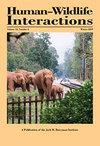视觉计数在确定加利福尼亚地松鼠管理工具功效方面的效用
IF 0.9
4区 环境科学与生态学
Q4 BIODIVERSITY CONSERVATION
引用次数: 1
摘要
视觉计数经常被用来评估管理工具对地松鼠(Marmotini)的有效性,但这种方法的有效性尚未对许多地松鼠物种进行评估,包括加利福尼亚地松鼠(otospermoophilus spp.)。因此,我们使用加州地松鼠的目视计数来确定在美国加利福尼亚州中部的牧场中使用灭蟑剂处理过的燕麦粥的功效,并将这些结果与在同一地块使用带无线电项圈的地松鼠获得的功效值进行比较。我们还利用无线电项圈地松鼠的位置数据来探索普查地块周围所需缓冲区的大小,以便在使用视觉计数时提供准确的效果评估。我们没有观察到与两种监测策略相关的疗效差异,这表明视觉计数是一种有效的监测工具。我们观察到2个处理地块的效果较低,可能是由于地松鼠对这些地块的利用率较低。增加缓冲区的大小将增加目标种群对处理区域的利用,并有助于减少邻近地松鼠种群的再次入侵,这可能会使效果值偏低。我们建议在人口普查地块周围至少有61米的缓冲区。增加到66米或更多将进一步有利于有效性评估,但缓冲区面积的增加必须与更大的成本和监管限制相平衡。本文章由计算机程序翻译,如有差异,请以英文原文为准。
Utility of Visual Counts for Determining Efficacy of Management Tools for California Ground Squirrels
Visual counts are frequently used to assess efficacy of management tools for ground squirrels (Marmotini), but the effectiveness of this approach has not been assessed for many ground squirrel species including California ground squirrels (Otospermophilus spp.). As such, we used visual counts of California ground squirrels to determine the efficacy of diphacinonetreated oat groat applications in rangelands in central California, USA, and compared those results to efficacy values derived from the use of radio-collared ground squirrels in the same plots. We also used location data of radio-collared ground squirrels to explore the size of buffer zone needed around census plots to provide an accurate assessment of efficacy when using visual counts. We did not observe a difference in efficacy associated with the 2 monitoring strategies, indicating that visual counts are an effective monitoring tool for ground squirrels. We observed low efficacy in 2 treatment plots, likely due to low usage of those plots by ground squirrels. Increasing the size of buffer zones would increase the usage of treatment areas by the target population and would help to minimize reinvasion by adjacent ground squirrel populations, which could bias efficacy values low. We suggest a minimum of a 61-m buffer surrounding census plots. Increasing to 66 m or more would further benefit efficacy assessments, but increased size of the buffer zone must be balanced with greater costs and regulatory constraints.
求助全文
通过发布文献求助,成功后即可免费获取论文全文。
去求助
来源期刊

Human–Wildlife Interactions
Environmental Science-Nature and Landscape Conservation
CiteScore
2.80
自引率
0.00%
发文量
0
审稿时长
11 weeks
期刊介绍:
Human–Wildlife Interactions (HWI) serves the professional needs of the wildlife biologist and manager in the arena of human–wildlife conflicts/interactions, wildlife damage management, and contemporary wildlife management. The intent of HWI is to publish original contributions on all aspects of contemporary wildlife management and human–wildlife interactions with an emphasis on scientific research and management case studies that identify and report innovative conservation strategies, technologies, tools, and partnerships that can enhance human–wildlife interactions by mitigating human–wildlife conflicts through direct and indirect management of wildlife and increased stakeholder engagement. Our intent is to promote a dialogue among wildlife professionals concerning contemporary management issues. As such, we hope to provide a repository for wildlife management science and case studies that document and share manager experiences and lessons learned.
 求助内容:
求助内容: 应助结果提醒方式:
应助结果提醒方式:


